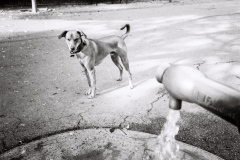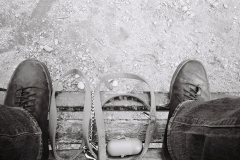Back before digital, I didn’t develop film or do my own printing. I had tried development but found an uninteresting simple process with a lot of overheard. My favorite 35mm film was Kodachrome 64 which was only developed by Kodak so that was just fine. For more interpretive artistic work I favored SX-70 Time Zero instant film. Again no development work for me. K64 production ceased in 2009 and just prior Polaroid had stopped making Time-Zero. The writing was on the wall with respect to my film future. It was my signal to move on in total.
I had already picked up a digital camera; a Kodak DC 290. A lump of a camera with a 29-58mm zoom and 2 mega pixel resolution. It took compact flash cards and AA batteries. I used that camera like mad completely liberated from cost and hassle of film.
Back in the late 90s, when digital cameras were just emerging as affordable and capable, I was a ready customer. I had been shooting film since 1986. I found the appeal of a digital world irresistible. No more filing negatives, messing around with contact prints, hustling to the lab for one thing or another and of course no more buying film. The quality was good enough given the process advantages. I had already made my move before my favorite films disappeared, but not for “artistic” work. The Polaroid remained my favorite for expressive images.
As my photography has changed over the years, I started favoring a lo-fi look. This started in my Polaroid days but has evolved and changed over time. I can make this happen with digital, but I have learned that film shot through a compact camera hits this lo-fi look in a much more direct method. I hadn’t considered film again until I was again browsing Daido Moriyama’s work. He shot with cheap point and shoot film cameras mostly. I don’t aim to imitate him, but I do tend towards lo-fi, extemporaneous images. After 30 some years with digital, I am returning to shooting film. Occasionally, as a choice.
I started out looking for a film Leica (M-something) so I could use my lens library. The pricing on analog Leicas was off putting to say the least. $3000 or more for an analog Leica body was more than I was willing to risk on an idea (shooting film again) that I am not even sure that I will enjoy. The Leica CL got a look and I quickly moved to the Minolta CLE (superior in every way over the Leica) which would still allow access to my lens library. Unfortunately, most of the CLEs were in Japan rather than Europe and I preferred sourcing something from inside the EU customs border.
Back in the 80s I had wanted an Olympus XA to go with my Olympus OM SLR system. In those days the XA was just too expensive to make it happen. They were about $180US, a king’s ransom in my world then for a camera that was not going to be my main system. In today’s world, a quick search on EBAY found quite a few available in Europe for reasonable prices (about 180€) so I bought one with the A11 flash. Nicely integrated, accurate metering, rangefinder focusing, and a small form factor make this camera a winner in my book. It sort of reminds me of my Ricoh GRII in the way it functions as an image making tool.
It has become one of my out and around cameras but also used with deliberation at times. Here are a couple images from the first roll of film I’ve shot in 30 years.
Discover more from Kevin Foust
Subscribe to get the latest posts sent to your email.


